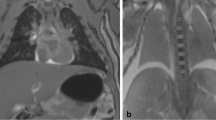Abstract
Objectives
The aim of this preliminary study is to evaluate whether pleural fluid accumulates following death in a predictable manner, in particular whether such collections are related to post-mortem interval.
Methods
Images acquired by post-mortem magnetic resonance imaging (PMMR) were both subjectively and objectively assessed for extent of pleural fluid accumulation. Total thoracic volume and pleural fluid volume were calculated using segmentation functions on OSIRIX software. The percentage of pleural fluid as a percentage of thoracic volume was calculated, to account for variation in subject size. The cause of death as per the final autopsy report and the interval from death to imaging were also recorded.
Results
Twelve perinatal deaths/stillbirths (mean gestation 38 weeks, range 24–48 weeks, male/female 5:7) and 11 childhood deaths (mean age 1 year, range 1 day–4 years, male/female 3:8) were assessed. The mean interval from death to imaging for all cases was 7.5 days (range 1–23 days). Pleural fluid was present in almost all cases, and the mean percentage pleural effusion as a proportion of thoracic volume was 3.3 % (range 0.2–9.5 %). There was a significant correlation between the post-mortem interval and the amount of pleural fluid in childhood deaths (p < 0.05) but no significant relationship for perinatal deaths.
Conclusion
The accumulation of pleural fluid detectable on PMMR in children is related to post-mortem interval. If this holds for a larger population, it may therefore be a useful marker for estimating time of death. A similar relationship was not found for perinatal deaths and stillbirths, the reasons for which remain uncertain.





Similar content being viewed by others
Abbreviations
- (PM)MR:
-
(Post-mortem) magnetic resonance imaging
References
Anders S, Kunz M, Gehl A, Sehner S, Raupach T, Beck-Bornholdt HP (2013) Estimation of the time since death - reconsidering the re-establishment of rigor mortis. Int J Legal Med 127(1):127–130
Smart JL, Kaliszan M (2012) The post mortem temperature plateau and its role in the estimation of time of death. Leg Med (Tokyo) 14(2):55–62
Vass AA (2011) The elusive universal post-mortem interval formula. Forensic Sci Int 204(1-3):34–40
Cherix D, Wyss C, Pape T (2012) Occurrences of flesh flies (Diptera: Sarcophagidae) on human cadavers in Switzerland, and their importance as forensic indicators. Forensic Sci Int 220(1-3):158–163
Lendoiro E, Cordeiro C, Rodríguez-Calvo MS, Vieira DN, Suárez-Peñaranda JM, López-Rivadulla M, Muñoz-Barús JI (2012) Applications of Tandem Mass Spectrometry (LC-MSMS) in estimating the post-mortem interval using the biochemistry of the vitreous humour. Forensic Sci Int 223(1-3):160–164
Scheurer E, Ith M, Dietrich D, Kreis R, Hüsler J, Dirnhofer R, Boesch C (2005) Statistical evaluation of time-dependent metabolite concentrations: estimation of post-mortem intervals based on in situ 1H-MRS of the brain. NMR Biomed 18(3):163–172
Sharma S, Singh D, Kaul D (2015) AATF RNome has the potential to define post mortem interval. Forensic Sci Int 247:e21–e24
Donaldson AE, Lamont IL (2013) Biochemistry changes that occur after death: potential markers for determining post-mortem interval. PLoS One 8(11):e82011
Kang X, Cos T, Guizani M, Cannie MM, Segers V, Jani JC (2014) Parental acceptance of minimally invasive fetal and neonatal autopsy compared with conventional autopsy. Prenat Diagn 34(11):1106–1110
Thayyil S, Sebire NJ, Chitty LS, MARIAS collaborative group et al (2013) Post-mortem MRI versus conventional autopsy in fetuses and children: a prospective validation study. Lancet 382:223–233
Miller KL, Stagg CJ, Douaud G et al (2011) Diffusion imaging of whole, post-mortem human brains on a clinical MRI scanner. Neuroimage 57(1):167–181
Arthurs OJ, Price GC, Carmichael D, Jones R, Norman W, Taylor AM, Sebire NJ (2015) Diffusion-weighted perinatal post-mortem MRI as a marker of post mortem interval. Eur Radiol 25:1399–1406
Fischer F, Grimm J, Kirchhoff C, Reiser MF, Graw M, Kirchhoff S (2012) Postmortem 24-h interval computed tomography findings on intrahepatic gas development and changes of liver parenchyma radiopacity. Forensic Sci Int 214(1-3):118–123
Ishida M, Gonoi W, Hagiwara K, Okuma H, Shintani Y, Abe H, Takazawa Y, Ohtomo K, Fukayama M (2014) Fluid in the airway of nontraumatic death on postmortem computed tomography: relationship with pleural effusion and postmortem elapsed time. Am J Forensic Med Pathol 35(2):113–117
Hyodoh H, Shimizu J, Watanabe S, Okazaki S, Mizuo K, Inoue H (2015) Time-related course of pleural space fluid collection and pulmonary aeration on postmortem computed tomography (PMCT). Leg Med (Tokyo)
Shiotani S, Kobayashi T, Hayakawa H, Kikuchi K, Kohno M (2011) Postmortem pulmonary edema: a comparison between immediate and delayed postmortem computed tomography. Leg Med (Tokyo) 13(3):151–155
Sienko A, Altshuler G (1999) Meconium-induced umbilical vascular necrosis in abortuses and fetuses: a histopathologic study for cytokines. Obstet Gynecol 94(3):415
Acknowledgments
OA is funded by an NIHR Clinician Scientist Fellowship award, and NJS is funded by a NIHR Senior Fellow award. NJS is partially supported by the Great Ormond Street Children’s Charity and the Great Ormond Street Hospital Biomedical Research Centre. This article presents independent research funded by the National Institute for Health Research (NIHR) and supported by the Great Ormond Street Hospital Biomedical Research Centre. The views expressed are those of the author(s) and not necessarily those of the NHS, the NIHR or the Department of Health.
Author information
Authors and Affiliations
Corresponding author
Ethics declarations
Conflict of interest
The authors declare that they have no conflicts of interest.
Rights and permissions
About this article
Cite this article
Barber, J.L., Hutchinson, J.C., Sebire, N.J. et al. Pleural fluid accumulation detectable on paediatric post-mortem imaging: a possible marker of interval since death?. Int J Legal Med 130, 1003–1010 (2016). https://doi.org/10.1007/s00414-016-1320-9
Received:
Accepted:
Published:
Issue Date:
DOI: https://doi.org/10.1007/s00414-016-1320-9




